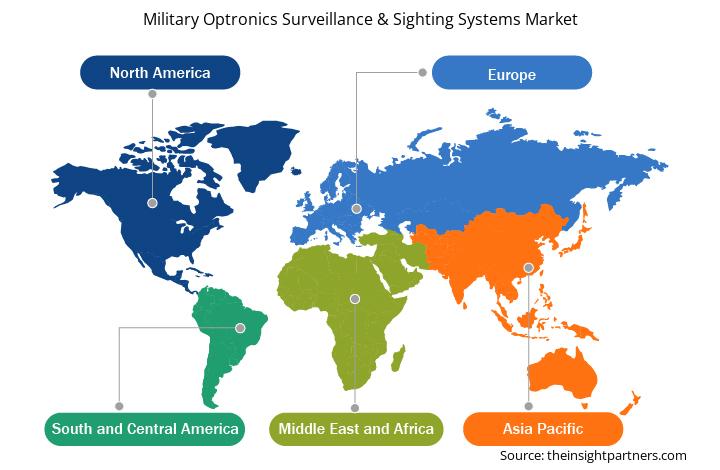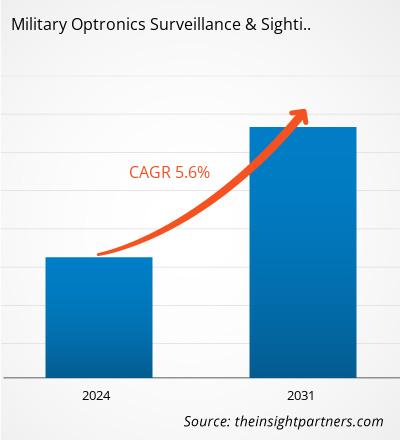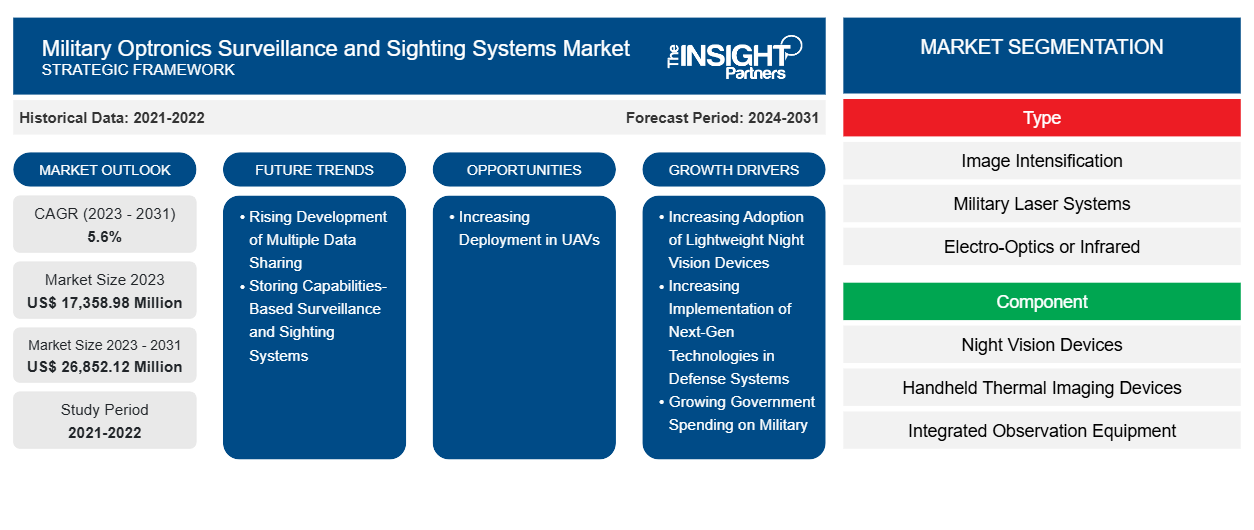Le marché des systèmes de surveillance et de visée optroniques militaires devrait atteindre 26 852,12 millions USD d'ici 2031, contre 17 358,98 millions USD en 2023. Le marché devrait enregistrer un TCAC de 5,6 % au cours de la période 2023-2031. Le développement croissant de systèmes de surveillance et de visée basés sur des capacités de partage et de stockage de données multiples devrait apporter de nouvelles tendances clés sur le marché dans les années à venir.
Analyse du marché des systèmes de surveillance et de visée optroniques militaires
Avec l'innovation croissante et la menace croissante des attaques terroristes de nuit, l'adoption d'appareils de vision nocturne augmente. De même, l'imagerie thermique aide les soldats à localiser une cible dans des conditions de mauvaise visibilité. Les appareils de vision nocturne à imagerie thermique gagnent en popularité dans le monde entier pour renforcer les systèmes individuels des combattants. Les appareils de vision nocturne offrent aux soldats une meilleure connaissance de la situation en éclairant leur environnement pendant les opérations de nuit. L'augmentation des initiatives gouvernementales visant à développer et à adopter des appareils de vision nocturne légers basés sur des technologies avancées a créé une demande massive pour la croissance du marché des systèmes de surveillance et de visée optroniques militaires. Par exemple, en janvier 2022, la Defence Advanced Research Projects Agency (DARPA) du ministère américain de la Défense a sélectionné 10 équipes de recherche de la défense et universitaires pour le développement d'optiques de vision nocturne légères pour les soldats militaires américains. Le département a conçu le programme Enhanced Night Vision in Eyeglass Form (ENVision) pour adopter la nouvelle technologie afin de développer des systèmes de vision nocturne.
Français Le déploiement croissant de drones à travers le monde pour protéger les terres des pays voisins devrait créer de nombreuses opportunités pour la croissance du marché des systèmes de surveillance et de visée optroniques au cours de la période de prévision. Par exemple, en 2022, l'armée indienne a déployé le premier lot de plus de 25 drones de fabrication israélienne nommés Searcher Mark II. De plus, en mai 2024, le gouvernement américain a commencé à livrer des drones à son armée dans le cadre de son programme gouvernemental visant à contrer les capacités de défense de la Chine. De plus, en mars 2023, des scientifiques chinois ont développé un drone militaire capable de se diviser rapidement en six unités distinctes dans les airs. Ces drones sont fabriqués avec des technologies de séparation d'air. Cet investissement croissant et le déploiement de drones par les gouvernements de plusieurs pays devraient créer de nombreuses opportunités pour le marché des systèmes de surveillance et de visée optroniques au cours de la période de prévision.
Aperçu du marché des systèmes de surveillance et de visée optroniques militaires
Les systèmes d'optronique, de surveillance et de visée militaires équipent le personnel d'outils suffisants pour identifier, suivre, surveiller et affronter les menaces dans les environnements de guerre aérienne, terrestre et navale. Ces systèmes fournissent aux forces armées une détection, une reconnaissance et une identification précises des cibles et une connaissance de la situation grâce à une intégration de composants optiques hautes performances et de capteurs avancés. En outre, les systèmes d'optronique, de surveillance et de visée trouvent une application pour répondre aux exigences des missions de contrôle des frontières, de protection des bases, de reconnaissance et de collecte de renseignements. Les avancées technologiques dans les systèmes d'optronique et de surveillance, associées à la demande continue des forces de défense de mettre à niveau leurs équipements et systèmes existants, stimulent le marché mondial des systèmes d'optronique, de surveillance et de visée militaires.
Personnalisez ce rapport en fonction de vos besoins
Vous bénéficierez d'une personnalisation gratuite de n'importe quel rapport, y compris de certaines parties de ce rapport, d'une analyse au niveau des pays, d'un pack de données Excel, ainsi que de superbes offres et réductions pour les start-ups et les universités.
-
Obtenez les principales tendances clés du marché de ce rapport.Cet échantillon GRATUIT comprendra une analyse de données, allant des tendances du marché aux estimations et prévisions.
Moteurs et opportunités du marché des systèmes de surveillance et de visée optroniques militaires
Adoption croissante d'appareils de vision nocturne légers
Avec l'innovation croissante et la menace croissante des attaques terroristes nocturnes, l'adoption d'appareils de vision nocturne augmente. Auparavant, les appareils de vision nocturne utilisaient des composants relativement plus lourds, ce qui ajoutait du poids au soldat. Divers acteurs du marché introduisent désormais des produits de vision nocturne légers. Par exemple, ACTinBlack a développé un appareil de vision nocturne binoculaire léger avec des performances optiques élevées et une conception ergonomique. En octobre 2023, Thermoteknix Systems, une société américaine d'imagerie thermique et de réalité augmentée (AR), a lancé une solution de vision nocturne appelée Fused Night Vision Goggle avec réalité augmentée avancée (FNVG-AR). Le système FNVG-AR est un système de lunettes de vision nocturne binoculaires légères (NVG) intégrées à des tubes de vision nocturne au phosphore blanc de 16 mm de nouvelle génération basés sur une technologie avancée et à un imageur thermique haute résolution.
Déploiement croissant des drones
Les systèmes sans pilote sont devenus partie intégrante des forces militaires du monde entier car ils réduisent les risques pour la vie humaine. En raison des divers avantages offerts par les véhicules aériens sans pilote (UAV), de nombreux pays, tels que les États-Unis, l'Inde et la Chine, ont alloué des budgets substantiels pour déployer davantage de drones dans leurs forces militaires, principalement pour des applications de surveillance. Le déploiement de systèmes de surveillance et de visée optroniques sur des plates-formes sans pilote facilite la transmission de données de surveillance et d'imagerie. L'intégration de systèmes sans pilote avec des antennes de communication et d'autres équipements de surveillance aide à diverses missions critiques. Par conséquent, le déploiement croissant de drones pour des missions de surveillance et de cartographie aéroportées et navales entraîne un besoin croissant de systèmes de surveillance et de visée optroniques qui peuvent être efficacement intégrés à la plate-forme UAV sans entraver son efficacité globale. Ainsi, plusieurs acteurs majeurs de l'industrie, dont Rafael Advanced Defense Systems Ltd. et Lockheed Martin, sur le marché des systèmes de surveillance et de visée optroniques militaires mettent l'accent sur le développement et l'offre de systèmes de surveillance et de visée optroniques pour les plates-formes UAV.
Analyse de segmentation du rapport sur le marché des systèmes de surveillance et de visée optroniques militaires
Les segments clés qui ont contribué à l’élaboration de l’analyse du marché des systèmes de surveillance et de visée optroniques militaires sonttype, composant et utilisateurs finaux.
- En fonction du type, le marché des systèmes de surveillance et de visée optroniques militaires est classé en intensification d'image, systèmes laser militaires et électro-optique/infrarouge. Le segment électro-optique détenait la plus grande part du marché en 2023.
- Par composant, le marché est classé en appareils de vision nocturne, appareils d'imagerie thermique portables, équipements d'observation intégrés, capteurs infrarouges autonomes, capteurs sismiques et acoustiques, etc. Le segment des capteurs sismiques et acoustiques a dominé le marché en 2023.
- En termes d'utilisateurs finaux, le marché des systèmes de surveillance et de visée optroniques militaires est classé en terrestre, aéroporté et naval. Le segment terrestre détenait la plus grande part du marché en 2023.
Analyse des parts de marché des systèmes de surveillance et de visée optroniques militaires
La portée géographique du rapport sur le marché des systèmes de surveillance et de visée optroniques militaires offre une analyse mondiale détaillée. L'Amérique du Nord, l'Europe et l'Asie-Pacifique sont les principales régions qui connaissent une croissance significative sur le marché des systèmes de surveillance et de visée optroniques militaires. Le marché des systèmes de surveillance et de visée optroniques militaires en Amérique du Nord est en outre segmenté entre les États-Unis, le Canada et le Mexique. En 2023, les États-Unis ont dominé le marché des systèmes de surveillance et de visée optroniques militaires en Amérique du Nord avec une part de marché importante en 2023, suivis du Canada et du Mexique. Ces économies développées consacrent une part considérable de leur PIB aux dépenses militaires. Selon la collecte d'indicateurs de développement de la Banque mondiale, qui sont compilés à partir de sources officiellement reconnues, les dépenses militaires aux États-Unis auraient représenté environ 3,5 % de son PIB en 2023. De plus, au cours de l'exercice 2023, le gouvernement américain a dépensé 820 milliards de dollars américains pour le secteur de la défense nationale, selon le département fédéral américain du budget. Le montant a été estimé à 13 % des dépenses fédérales américaines. Les principaux acteurs du marché développent des technologies avancées basées sur des systèmes de surveillance optronique aéroportés, des caméras thermiques numériques avancées, des systèmes de suivi et de recherche, etc. Par exemple, la société américaine Obsidian Sensors Inc. a lancé en 2023 une nouvelle technologie qui traite l'imagerie thermique à l'aide de capteurs haute résolution abordables.
Aperçu régional du marché des systèmes de surveillance et de visée optroniques militaires
Les tendances et facteurs régionaux influençant le marché des systèmes de surveillance et de visée optroniques militaires tout au long de la période de prévision ont été expliqués en détail par les analystes d’Insight Partners. Cette section traite également des segments et de la géographie du marché des systèmes de surveillance et de visée optroniques militaires en Amérique du Nord, en Europe, en Asie-Pacifique, au Moyen-Orient et en Afrique, ainsi qu’en Amérique du Sud et en Amérique centrale.

- Obtenez les données régionales spécifiques au marché des systèmes de surveillance et de visée optroniques militaires
Portée du rapport sur le marché des systèmes de surveillance et de visée optroniques militaires
| Attribut de rapport | Détails |
|---|---|
| Taille du marché en 2023 | 17 358,98 millions de dollars américains |
| Taille du marché d'ici 2031 | 26 852,12 millions de dollars américains |
| Taux de croissance annuel composé mondial (2023-2031) | 5,6% |
| Données historiques | 2021-2022 |
| Période de prévision | 2024-2031 |
| Segments couverts |
Par type
|
| Régions et pays couverts |
Amérique du Nord
|
| Leaders du marché et profils d'entreprises clés |
|
Densité des acteurs du marché des systèmes de surveillance et de visée optroniques militaires : comprendre son impact sur la dynamique commerciale
Le marché des systèmes de surveillance et de visée optroniques militaires connaît une croissance rapide, tirée par la demande croissante des utilisateurs finaux en raison de facteurs tels que l'évolution des préférences des consommateurs, les avancées technologiques et une plus grande sensibilisation aux avantages du produit. À mesure que la demande augmente, les entreprises élargissent leurs offres, innovent pour répondre aux besoins des consommateurs et capitalisent sur les tendances émergentes, ce qui alimente davantage la croissance du marché.
La densité des acteurs du marché fait référence à la répartition des entreprises ou des sociétés opérant sur un marché ou un secteur particulier. Elle indique le nombre de concurrents (acteurs du marché) présents sur un marché donné par rapport à sa taille ou à sa valeur marchande totale.
Les principales entreprises opérant sur le marché des systèmes de surveillance et de visée optroniques militaires sont :
- Airbus
- Société Lockheed Martin
- Groupe Thales
- Société General Dynamics
- L3Harris Technologies Inc.
- Industries aérospatiales israéliennes
Avis de non-responsabilité : les sociétés répertoriées ci-dessus ne sont pas classées dans un ordre particulier.

- Obtenez un aperçu des principaux acteurs du marché des systèmes de surveillance et de visée optroniques militaires
Actualités et développements récents du marché des systèmes de surveillance et de visée optroniques militaires
Le marché des systèmes de surveillance et de visée optroniques militaires est évalué en collectant des données qualitatives et quantitatives après des recherches primaires et secondaires, qui comprennent d'importantes publications d'entreprise, des données d'association et des bases de données. Quelques-uns des développements du marché des systèmes de surveillance et de visée optroniques militaires sont répertoriés ci-dessous :
- Le spécialiste des capteurs HENSOLDT fournit un nombre indéterminé de systèmes de vision optique de pointe pour le véhicule de combat d'infanterie PUMA. Les clients sont les sociétés de systèmes KNDS et Rheinmetall, qui produisent le véhicule de combat d'infanterie PUMA et le distribuent par l'intermédiaire de la société PSM GmbH fondée conjointement. La valeur de la commande est de plusieurs millions de dollars. Outre les systèmes de vision pour les tourelles des véhicules de combat d'infanterie, la commande comprend l'équipement de douze simulateurs de tourelle pour la formation des équipages des véhicules. Avec cette livraison, HENSOLDT contribue à améliorer le PUMA sur le stand K S1. (Source : HENSOLDT, communiqué de presse, juin 2024)
- Les forces françaises ont réceptionné les 300 premières jumelles de vision nocturne Thales commandées par la Direction générale de l’armement (DGA) en 2020 dans le cadre du contrat Bi-NYX. Les 300 jumelles livrées à la DGA constituent le premier lot d’une commande de 2 000 jumelles passée en décembre 2023. Les 1 700 autres seront expédiées d’ici la fin de cette année. (Source : Thales, Communiqué de presse, octobre 2024)
Rapport sur le marché des systèmes de surveillance et de visée optroniques militaires : couverture et livrables
Le rapport « Taille et prévisions du marché des systèmes de surveillance et de visée optroniques militaires (2021-2031) » fournit une analyse détaillée du marché couvrant :
- Taille et prévisions du marché des systèmes de surveillance et de visée optroniques militaires au niveau des pays pour tous les segments de marché clés couverts par le périmètre
- Tendances du marché des systèmes de surveillance et de visée optroniques militaires, ainsi que la dynamique du marché, comme les facteurs moteurs, les contraintes et les opportunités clés
- Analyse PEST et SWOT détaillée
- Analyse du marché des systèmes de surveillance et de visée optroniques militaires couvrant les principales tendances du marché, le cadre national, les principaux acteurs, les réglementations et les développements récents du marché
- Analyse du paysage industriel et de la concurrence couvrant la concentration du marché, l'analyse de la carte thermique, les principaux acteurs et les développements récents pour le marché des systèmes de surveillance et de visée optroniques militaires
- Profils d'entreprise détaillés
- Analyse historique (2 ans), année de base, prévision (7 ans) avec TCAC
- Analyse PEST et SWOT
- Taille du marché Valeur / Volume - Mondial, Régional, Pays
- Industrie et paysage concurrentiel
- Ensemble de données Excel
Rapports récents
Rapports connexes
Témoignages
Raison d'acheter
- Prise de décision éclairée
- Compréhension de la dynamique du marché
- Analyse concurrentielle
- Connaissances clients
- Prévisions de marché
- Atténuation des risques
- Planification stratégique
- Justification des investissements
- Identification des marchés émergents
- Amélioration des stratégies marketing
- Amélioration de l'efficacité opérationnelle
- Alignement sur les tendances réglementaires























 Obtenez un échantillon gratuit pour - Marché des systèmes de surveillance et de visée optroniques militaires
Obtenez un échantillon gratuit pour - Marché des systèmes de surveillance et de visée optroniques militaires